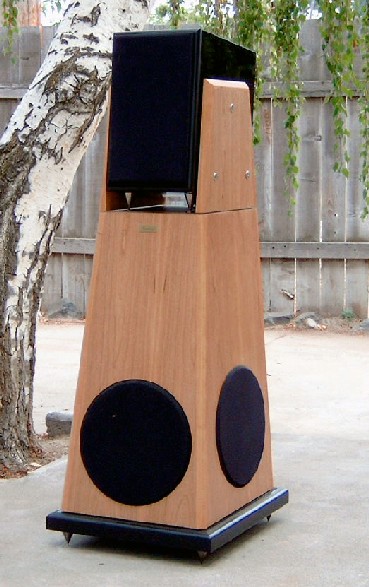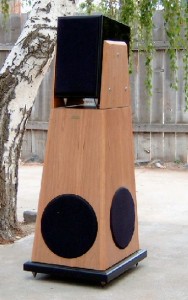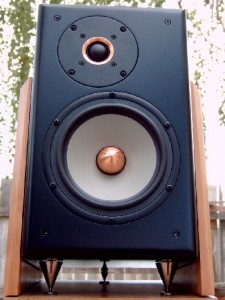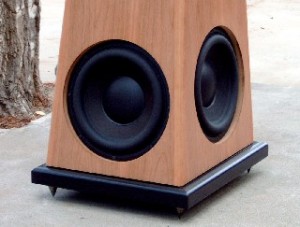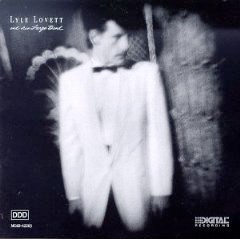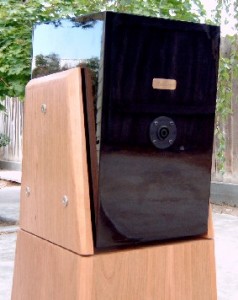Bamberg Engineering Sound Lab has just released a full range speaker system that falls into the category of “affordable high-end audio.” The Bamberg Series 5 speaker system has all the desirable qualities that a reference grade speaker is supposed to have; yet it is priced within the reach of the average audio enthusiast. The Series 5 is a twopiece speaker system, with a two way monitor positioned on top of an amplified bass module. The amplifiers for the bass modules, and a passive crossover network for the monitors reside in two small cabinets that are separate from the speaker system. At first glance, one might consider this speaker system to be a variation of the traditional satellite/ subwoofer speaker system that is favored by many audio enthusiasts. The Bamberg Series 5 is an integrated speaker system that has been carefully engineered to ensure a seamless blend between the two speaker modules. This is a difficult task for the typical satellite and subwoofer speaker combination. In fact, many audio enthusiasts struggle to achieve an acceptable blend between these two pieces in their speaker system.(1) The goal of A$$A is to focus on equipment that offers genuine quality sound reproduction for a reasonable price. This speaker system may be at the upper end that most people would consider affordable, however, the Series 5 separates itself from the run of the mill speakers that audio enthusiasts usually encounter in their audio journey. The Bamberg Series 5 speaker is a high performance piece of audio gear that is within the financial reach of most audio enthusiasts.
Specifications:
Transducers
- 18cm woofer SEAS W18ex-001
- 25mm tweeter SEAS Millennium
Impedance
- Nominal 8 ohm
- Minimum (@160 / 3000 Hz) 7.6 / 4.8 ohm
- Phase (@70 / 100k Hz) -46 / +25 degrees
Amplitude response
- To 20kHz +1.5 / -2.4 dB
Dispersion Sensitivity
- 2.83V@1-Meter full space 83.0 dB
Bass alignment
- Sealed HPF2 @65Hz, 0.60 Qtc
Inter-driver Phase response
- 400Hz to 9kHz Less than 35° phase difference
Maximum linear output
- 99dB 56W HPF2 @80Hz, all frequencies, no compression
- 96dB 28W No HPF, all frequencies, no compression
Crossover
- Alignment Linkwitz-Riley 4th @ 2.07 kHz
- Elements 20, 4 of which are in the series signal paths
- Phase compensation 4 elements in two circuits
Dimensions; Weight (Net)
- 14.0″H x 8.5″W x 13.0″D, 25 lb.
Active Subwoofer
Transducers
- 26cm woofer Peerless XLS-10” 30cm drone Peerless XLS-12”
Impedance
- Nominal 8 ohm
- Minimum (@110 Hz) 5.1 ohm
- Phase (@15/42Hz, 20kHz) -58 /+58 degrees
-3dB Bandwidth
- 18Hz to >500Hz, unfiltered
Dispersion Sensitivity
- 2.83V@1-Meter half space 84 dB
Bass alignment
- Drone system ~ Chebyshev 5th @21Hz
Maximum linear output
- 102 dB 165W HPF2 @23Hz 0.7Q, no compression
- 100 dB 90W no HPF, no compression
Crossover
- Alignment L-R 4th @80Hz (typical, but varies with monitor speaker)
Dimensions;
- Weight (Net) 25″H x 13″W x 18″D (including base), 55 lb.
- Price: Introductory $5980; Final $8275 pr.
Philip Bamberg is the man responsible for the development of the Series 5 speaker system. BESL produces a full line up of speakers, and provides engineering support to other commercial manufacturers. Philip is a graduate of Colorado University, with degrees in both electrical and mechanical engineering. Upon graduation, a typical career path for an engineer followed. Philip has held positions in the electrical, oil, and the medical fields. However, Philip’s passion has always been for audio, and he returned to the fold by taking on a position with Klipsch Audio Technologies. The THX Ultra II home theater speaker system is one of the primary accomplishments of his tenure at Klisph Audio.(2) Philip Bamberg combined his passion for music reproduction with his technical education, and developed a line of speakers that offer affordable high-end performance.
The monitor portion of the Bamberg Series 5 loudspeaker utilizes a SEAS 25mm Millennium tweeter, and an 18cm SEAS W18ex-001 Excel mid-bass driver. Philip chose to use a sealed enclosure for the monitor, and the passive crossover is a 4th order Linkwitz-Riley configuration. The monitors are heavily braced and internally dampened, which is to be expected from a speaker with world-class aspirations. The cabinets have a flawless piano black finish, which is stunningly beautiful. One interesting design feature of the Bamberg speaker system is that isolation spikes are used to give the monitor 6 degrees of backward tilt. This tilt improves the phase coherence of the speaker, and Philip Bamberg states that 2/3 of the time delay between the drivers can be eliminated with this set up position. While the Series 5 monitor bears a visual resemblance to other speakers in BESL product line, this is a specialized design that has specific attributes necessary to seamlessly integrate with the subwoofer module.
The subwoofer module of the Series 5 speaker system contains a 10-inch Peerless XLS bass driver. The bass driver is located on the front baffle, and two 10-inch passive radiators are located on the sidewalls of the enclosure. The Peerless driver is a high performance woofer, with a whole slew of attributes that make it a logical choice for this application. The cabinet for the bass module is robust, with 1.5-inch thick front and side plates. A sophisticated “spine” brace is attached to the rear panel, which increases the rigidity of the cabinet, and modifies the resonance characteristics. The bass module cabinet is built from conventional materials, and proven construction techniques. This choice of materials and design characteristics allows Philip Bamberg to keep the price of the Series 5 speaker system reasonable, and still allow the drivers to achieve their full potential. The cherry finish on the review pair has an intricate grain pattern, and a flawless satin finish. The Series 5 speaker system has a striking appearance, with a distinctive contrast between the natural beauty of the cherry wood grain and the elegant black piano finish of the monitors.
The dedicated amplifiers that power the bass modules are located in small enclosures that can be placed in an unobtrusive spot in the listening room. The passive crossover network for the mid-bass and tweeter is also contained in these modules. A hardwired speaker cable makes the connection between the passive crossover network and the monitor portion of the speaker. Since a high pass electronic crossover is utilized in this speaker system, it is necessary to have two sets of RCA cables feeding the two amplifier stages.(3) Philip sources a high quality plate amplifier for powering the bass modules.(4) A series of upgrades are then installed into the amplifier in order to enhance the performance of these units. There are several adjustments on the bass module amplifiers that can be used to properly match the Bamberg speaker system to the listening environment. There are controls for output level, crossover point, and phase alignment. Controls of this type are standard on most subwoofers, or powered speaker systems. Philip has added a set of adjustments allow the user to shape the output of the bass module in order to compensate for the acoustics of the listening room. There is a default setting for the bass module amplifier controls that will allow the user to achieve excellent bass performance in the majority of applications. Philip feels that 90% of typical speaker applications can use these settings, and that owners of the System 5 speaker system should begin with these set points. If a particular room requires different parameters, then the owner can make the necessary adjustments needed to achieve the desired performance. The Bamberg speaker system is designed to not only offer high quality bass performance, but it is also easy to set up so that the average audio enthusiast will be capable of obtaining optimum performance from these speakers.
The complexity of designing a passive crossover network is one aspect of speaker manufacturing that many audio enthusiasts fail to appreciate. In this day and age, computer aided design programs spit out basic crossover circuits that allow the weekend hobbyist to build a respectable speaker system. Philip Bamberg begins the crossover design with a computer simulation, but that is only the starting point of the whole process. Once the crossover points and slopes are calculated, Philip then programs these parameters into an electronic crossover, and begins the evaluation process of the initial design. Once the crossover design is finalized, then the real magic begins. Executing a passive crossover network that has similar sonic attributes, as the electronic model is a difficult task. There are many thorny issues to address in passive crossover network design, such as phase and time alignment, smoothing the impedance curve the amplifier must drive, notch filters that address any peaks in the driver frequency response, and other esoteric points that escape the understanding of the casual audio enthusiast. The crossover network in the Series 5 monitor is a complex 17-piece crossover network, however only 5 pieces are directly in the signal path. Phillip stressed his crossover design philosophy quite adamantly, and this quote succinctly states his position.
“I also wanted to point out that the passive crossovers are constructed to blow the signal through in as unimpeded way as possible. If you were to see the layout of the crossovers, you can see the way the components are ordered and oriented in such a way as to minimize coil interaction, use of components leads to preclude use of jumpers, etc., etc. We have performed tests to verify that there is NO transformer ill-effect to the passive network.”
It may seem counter-intuitive to the audio enthusiast that a high part crossover network will not color the sound of a speaker system. Philip advocates the benefits of steep crossover points, but he uses the fewest parts possible to properly control the drivers. The design target of the passive crossover network is the sonic signature of the electronic network that the prototype speaker is voiced with. The passive network inside the Bamberg Series 5 speaker system is an engineering triumph, and makes a significant contribution to the world-class performance of these speakers.
Bamberg Series 5 review
The amplification components of my review system consist of a Jeff Rowland Consummate pre-amplifier, and a Model 5 power amplifier. The Model 5 amplifier produces 150 wpc into 8 ohms, and drives only the monitor portion of the Series 5 speaker system. Source duties are taken care of by a Bolder Cable Company modified Squeezebox and an Audio Magic Kukama digital to analog converter. The speaker wires, interconnects, and digital cable come from the Audio Magic Illusion 4D product line. Power cords come from the less expensive Audio Magic Extreme series of cables. An Audio Magic Mini-Reference power conditioner takes care of the task of providing quality AC current to the rest of the system. Speakers are placed three feet off the rear wall, and placed eight feet apart. A small amount of toe in is necessary to lock in the soundstage.
Writing a description of the performance of the monitor portion of the Bamberg Series 5 speaker System is relatively simple. I can use words such as transparent, fast, and detailed. Other certain stock review phrases come to mind. I could say these speakers are free from grain, lift a veil from the music, or place instruments and singers directly into the listening room. These are all accurate descriptors of the Bamberg speaker system, but they fall short of conveying the essence of my listening experience with them. Never the less, I will relate my thoughts as best as I can, and keep in mind that the following paragraphs are at best a limited description of a fine speaker system. Much to my family’s dismay, I have been a huge Rickie Lee Jones fan. RLJ has an unusual vocal style that is very difficult to reproduce clearly. The majority of the speakers that I have encountered smear the subtle phrasing of her singing, and this results in a jumbled presentation that ultimately results in people asking, “What did she just say?” Naked Songs is a live performance recording, done with only acoustic instruments. “Living It Up” [Naked Songs; Reprise 9-45950-2] features RLJ, her piano, and the audience. The Series 5 speaker system extracts every subtle nuance out of this song, and does it with the grace and good manners of a socialite. RLJ vocals are clearly presented, which is quite an accomplishment for any speaker system. The piano notes are sharp and clear, and the decay pattern is properly portrayed. Through most of the song, the audience is in a rapt silence, yet there are certain passages where they interject themselves into the performance. These periodic interjections reveal the size of the club this is recorded in. The monitors clearly present the size of the room, and it is easy to audibly “see” all the way to the edges of the venue. Philip stresses the advantages of his crossover design, and the superior traits of the SEAS drivers. From what I can hear, I would have to agree with him. The midrange and treble performance of the Bamberg Series 5 speaker system is as good as I have ever heard, these speakers can stand toe to toe with the heavyweights of the audio world.
The bass module of the Bamberg Series 5 speaker system turned in a performance that is worthy of an all-star. The bass module is fast, powerful, and rock solid. The bass extends to subterranean depths, and moves enough air to give music a physical dimension. I like reggae music, although I have a very limited exposure to the highly respected performers of this genre. One afternoon I found myself scrolling through the music menu on my Squeezebox looking for something interesting to listen to. I pulled up a disc from the Skadanks, and decided to play “Ism-Skism”. [Give Thanks; Elektra 61586-2] The quality and quantity of the bass information on this song made me quit reading a rather interesting book that I was into, and I just absorbed the excellent music emanating from the stereo system. The synthesized bass notes were lightening fast, with no smearing or overhang. As I cranked the volume up, the deep notes began to pressurize the room. Eventually I got the volume to dance club levels, and music stayed as clear and detailed as it was at lower listening volumes. With slightly more than 1000 watts on tap, I quickly violated whatever city noise ordinances are in place, and had a great time doing it.(5) The 3dB down point of the bass module is 18 hertz, and the output level is not drastically reduced at higher octaves. In other words, the Series 5 speaker system is capable of generating authentic 20-hertz bass, which is a feat that is achieved by only a few speaker systems. (6)
Lyle Lovett is often categorized as a country music performer, but this tag is really not an accurate description of his eclectic musical style. Lyle often tours with a big band, and incorporates blues, jazz, and gospel elements into his songs. Combine these diverse musical elements with off beat lyrics, and you get an entertaining and thought-provoking album. In “What Do You Do/The Glory of Love” [Lyle Lovett and His Large band; Curb Records MCAD 12263] Lyle teams up with Francine Reed for an acidic duet that will leave you chuckling through the entire three minutes of the song. This disc is a fantastic recording, which is no surprise since it is laid down on a Mitsubishi X-850 digital recorder, and mixed on the JVC mastering system. The Bamberg Series 5 speaker system gets everything right on this song, and is as close to neutral as any speaker system I have heard. Lyle and Francine’s voice are free from any coloration, and every subtle detail contained in their performance is on display for your enjoyment. The drum kit is equally detailed, with quick percussive notes, and the cymbals have a nice metallic sheen. The horn section is dynamic, and the instruments have a discernable bite to their notes. The bass line bounces along, and sounds exactly like an electric bass should. The realism of the wide range of instruments on this song is superb, and the Series 5 speaker system is spot on with every aspect of this recording.
In contemporary society storytelling has become somewhat of a lost art. If you have had the good fortune to encounter a talented storyteller, you can appreciate how this person can add an extra dimension to a tale without altering the piece. That’s what a world class speaker should also be able to accomplish. A speaker of this caliber can replay music without imprinting a sonic signature, yet be able to make the music come alive by relaying the emotional content of a song. This is the touchy-feely side of audio, and is not rooted in specifications, engineering data, or measurement graphs. The Bamberg Series 5 speaker system has this elusive trait, and this sets it apart from many other top-of-theline speaker systems. Tracy Chapman is an extraordinary storyteller, and she can craft a song that engages your thoughts and feelings. “Cold Feet” [New Beginning; Elektra 61850-2] is about a poor young boy who struggles to find his way in life. A life of hard work brings prosperity, but one wrong choice results in a tragic death. The song has an excessive amount of reverb, and the electric bass is turned up a bit too high. This disc is a highly polished recording, and it has the strengths and limitations of a slick commercial mix. In spite of all of this, Chapman turns in an inspired performance, and the Bamberg speakers find a way to bring this to my listening room. The Series 5 speaker system is technically accurate, and emotionally engaging.
Conclusions about Series 5
There are very few drawbacks to the Bamberg Series 5 speaker system. I suspect that certain audio enthusiasts may have an issue with the voicing of these speakers. This speaker system does not have any artificial warmth to its tonal balance, and it unearths the finest of details. This ability to relay the subtle shadings of a recording is a double-edged sword. If you are an audio enthusiast that craves a smooth and easy to listen to sound, then this speaker system may not work for you. Listening to well recorded music on the Series 5 speaker system can be a heavenly experience, while a poor recording might make you think that you have been sent to that “other” eternal resting place. The Bamberg Series 5 speakers are refined and can be smooth, however they do not gloss over the imperfections contained in a recording. Also, the modules that contain the bass amplifiers and passive crossover networks are somewhat large and bulky. These generic black boxes have minimal aesthetic appeal; however they are small enough to be tucked away in a relatively unobtrusive niche. The obsessive-compulsive audiophile might have an issue with the captive speaker wire between the passive crossover and the monitor portion of the Series 5 speaker system. This captive cord does not allow for the switching out of various speaker wires, and a perspective owner will have to get used to the idea that speaker wire is no longer a variable that can be manipulated in the system.(7) From my perspective, I thoroughly enjoyed the performance of this speaker. Philip is satisfied with the performance of this wire, and in light of what I hear; this is good enough for me. Other than these minor issues, I cannot fault these speakers in any significant performance category. There may be better speakers to be had, but I doubt they sell for less than $6000.(8)
The Bamberg Series 5 speaker system is a classic example of how high-end performance can be achieved through conventional engineering and construction techniques. Philip Bamberg does not circumvent the laws of physics, use an exotic material that has been blessed by Tibetan monks, or has a proprietary treatment process designed to enhance the performance of the parts he uses. The Series 5 speaker system uses the best drivers that SEAS and Peerless produces, however this is only one element needed to produce a reference quality speaker. Rigid and welldamped cabinets are also necessary in order to maximize the potential of the selected drivers. These cabinets use proven construction techniques and materials, which keeps the overall cost of the speaker in check. Thick front baffles and sidewalls are reinforced with stout internal braces in order to eliminate the effects of cabinet resonance. While these attributes play a significant role in the performance of the Bamberg Series 5 speaker system, the crossover network is the critical component that endows this speaker with its extraordinary performance. The electrical theory that Philip utilizes in his passive dividing network are proven techniques that are accepted and used by speaker manufacturers. Understanding the interrelationship between the crossover circuits, the drivers, and the acoustic effects of the cabinets is where Philip Bamberg displays his considerable talents as a speaker designer. The Bamberg Series 5 speaker system is a reference quality speaker that has no significant flaws or limitations. This is a full range speaker system that is well suited for jazz, classical, rock and roll, techno, or any other type of music that I am aware of. Reference quality components are long-term purchases, and the Bamberg speaker system would be a cornerstone to a high performance audio system. I would encourage audio enthusiasts from all walks of life to seek out a pair of BESL speakers and give them a serious audition.(9) Indeed, these speakers are a cut above the rest.
Equipment Used:
- Jeff Rowland Consummate pre-amplifier
- Jeff Rowland Model 5 amplifier
- Bolder Cable Company modified Squeezebox with Ultimate IV power supply
- Audio Magic Kukama DAC
- Audio Magic Mini-Reference power conditioner
- Audio Magic Illusion 4D interconnects, speaker wire and digital cable
- Audio Magic Extreme power cords
Manufacturer’s Response
We are thrilled that John enjoyed the Bamberg Series 5 TMW speaker system, and we are glad that our hard efforts were appreciated by him.
We are relieved that we did not receive a call from John asking for further help in adjusting the bass controls. He only had to set the gain level! I think that is proof that a modular active/passive 3-way speaker system can be delivered and setup to perform properly “straight out of the box”.
The power module enclosures may be ordered with custom finish to match the subwoofer. Also available by custom order are longer umbilical cables so that the power modules may be located further from the speakers, such as behind the equipment rack or potted plant. We chose not to overcome the challenge of fitting this high-performance bass amp on the back of the subwoofer, as that would have required a slightly larger cabinet, and compromised rigidity of the back panel. Besides, the fully finished back looks nice whenever the speakers are place farther out into the room.
We, too, believe that audio cables in general—and speaker cables especially—have an effect on the final sound. And while we understand and support the desire of many audiophiles to experiment with speaker cables, it must be realized that the Series 5 external umbilical cable actually makes up the lead wire harness from the output of the passive crossover to the midbass and tweeter drivers. Such a harness is internal to most other speakers, and therefore is not interchangeable. This proprietary cable has been selected and fabricated because of its very low losses (low intrinsic L-C-R values). For that very reason this same cable is the one we use in our lab for speaker test measurements, and it is 30 feet long! We do make regular speaker cables from this cable for our customers upon request. With 37 internal conductors (most of which are individually insulated by a high-dielectric) it can be made in several different configurations and terminations. Basically, changing out the umbilical cable would change the sound of the speaker in an uncontrolled way. Furthermore we have taken away all risk of an accidental connection of the tweeter to the midrange crossover by employing the pre-wired Neutrik twist-lock connector. You only have to mind the polarity of the regular speaker cables, as always.
Notes
1) The satellites in many sat/sub systems are also intended for full range use. So they are designed with maximum bass extension for stand-alone use. The subwoofer is often an add-on, intended to extend the bass response. The lower registers of the output of the satellite are often compromised, and this creates the difficulty of achieving a proper transition point to the subwoofer. Another issue is the improper matching of crossover networks. If these networks are not specifically designed to work together, a proper blend cannot be achieved between the two elements.
2) Although BESL was founded in 1993, Philip’s tenure at Klipsch occurred in 2000 to 2002. BESL existed during this time frame, although it was in hiatus.
3) The amplifier in the main system drives the monitor portion of the Series 5 speaker system. Since the high-pass portion of the electronic crossover cuts off the low bass to this leg of the stereo, the main amp does not have to be overly large or powerful. The second amplification stage is the plate amplifiers that are dedicated to running the bass modules.
4) The subwoofer amplifier uses MSOFET output devices, and produces 370 watts of power.
5) The subwoofer module amplifiers are 370 watts apiece, and the Rowland Model 5 delivers 150 watts per channel to the monitors.
6) Speakers that are capable of 20-hertz output are usually the size of a small refrigerator. The relatively compact size of the bassmodule means that full range performance can be achieved without giving up massive amounts of real estate in the listening room.
7) I would suspect that Philip Bamberg could be convinced to custom build a speaker system that allows for the use of aftermarket speaker wires.
8) The MSRP of the Series 5 speakers are $8275 a pair. BESL has an introductory special in place, and at this time a pair of speakers can be acquired for $5980.
9) The performance of the monitors is outstanding. If the details can be worked out, I would appreciate the opportunity to review a moderately priced BESL speaker.
from affordableaudio, By John Hoffman
